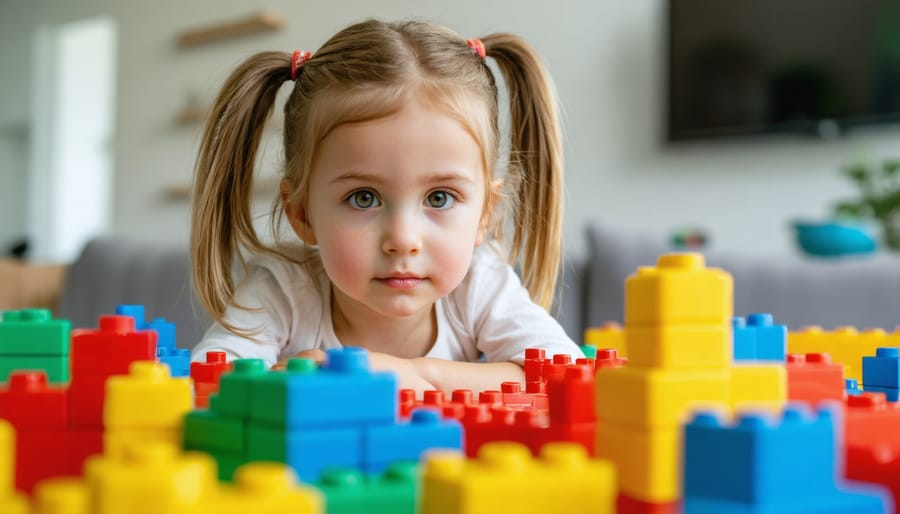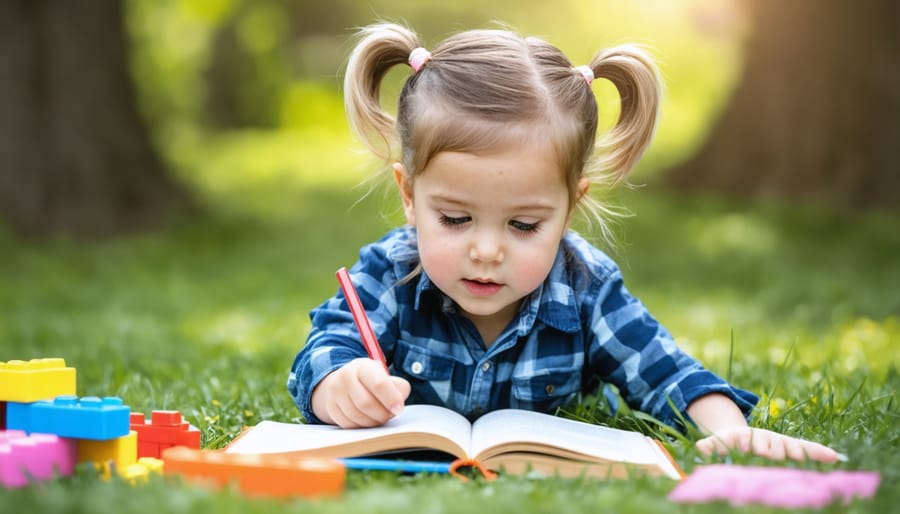Free Games That Actually Teach Your 5-Year-Olds (While They Think They’re Just Playing)
**Transform your kindergarten classroom into a learning playground without spending a dime.** Five-year-olds learn best through play, and the right games can teach crucial skills while keeping your classroom buzzing with engaged, happy learners. No fancy materials needed—just creativity and these tried-and-true game ideas.
**Use movement-based games to teach letters and numbers.** Have students jump to alphabet spots on the floor, hop through number sequences, or race to touch objects that start with specific sounds. These active games burn energy while building foundational literacy and math skills.
**Turn everyday transitions into learning opportunities.** Play “I Spy” with shapes during lineup, count backward while cleaning up, or sort materials by color as students put toys away. These quick games reinforce concepts without requiring dedicated game time.
**Customize simple templates for endless variety.** Bingo cards, memory match games, and sorting activities work for any subject—just swap the content. One template becomes a phonics game today and a counting game tomorrow, saving you precious planning time.
**Make games work for mixed abilities.** Adjust difficulty by changing rules, pairing students strategically, or offering visual supports. When games flex to meet each learner’s needs, everyone stays engaged and successful.
Why Game-Based Learning Works Magic with 5-Year-Olds
Five-year-olds are bundles of energy with curiosity that never seems to quit! At this age, children are developing crucial skills like taking turns, following simple rules, and building friendships—all while their attention spans hover around just 10-15 minutes. That’s where games become your secret weapon in the classroom.
Here’s the thing: kindergarteners learn best when they don’t even realize they’re learning. Their brains are wired for play. When you transform a lesson into a game, you’re speaking their natural language. They’re motivated by colors, sounds, movement, and the thrill of “winning” or completing a challenge. Suddenly, counting to twenty isn’t a chore—it’s part of an exciting race or treasure hunt!
The game-based learning benefits are especially powerful for this age group. Games provide immediate feedback (they know right away if they got it right), build confidence through small victories, and keep those wiggly bodies engaged. Plus, games naturally incorporate repetition without feeling boring, which is exactly how young children master new concepts.
At five, kids are also developing their social-emotional skills. Games teach them to wait their turn, celebrate others’ successes, and handle disappointment when they don’t win—life skills wrapped up in fun! When they’re laughing and moving during a phonics game, they’re building neural pathways that make reading stick.
The best part? You don’t need fancy equipment or hours of prep. Simple games that match their developmental stage—quick, active, and visually engaging—will have your kindergarteners begging for “just one more round” while you’re secretly checking off your learning objectives.

What Makes a Game Perfect for Your Kindergarten Classroom
Finding the perfect game for your kindergarten classroom doesn’t have to be complicated! When browsing through free learning games for 5-year-olds, keep these essential characteristics in mind to ensure success.
**Simple, Clear Rules**: Your games should have no more than 2-3 easy-to-follow steps. If you spend more than two minutes explaining the rules, it’s probably too complex. Think “freeze when the music stops” rather than multi-layered instructions that’ll leave little ones confused.
**Strong Visual Elements**: Five-year-olds are visual learners! Look for games with colorful pictures, bold shapes, or physical props they can touch and manipulate. Visual cues help students understand expectations without constant verbal reminders.
**Built-in Movement**: Kindergarteners need to wiggle! The best games incorporate jumping, dancing, reaching, or walking. Movement keeps energy levels manageable while supporting gross motor development—it’s a win-win for classroom management.
**Quick Rounds**: Attention spans at this age max out around 5-10 minutes. Choose games with short rounds that you can repeat or stop easily. This flexibility lets you adapt to your classroom’s energy level on any given day.
**Clear Learning Objectives**: Every game should target specific skills—whether it’s letter recognition, counting, color identification, or social-emotional learning. When you can clearly articulate what students will learn, you’ll feel confident the game is time well spent.
The beauty of these characteristics? You can customize almost any simple game to meet them!
Free Learning Games Your 5-Year-Olds Will Beg to Play Again
Literacy and Language Games
Building literacy skills at age five is all about making letters and sounds come alive! These free games turn abstract concepts into playful learning experiences that stick.
**PowerPoint Alphabet Adventures** are perfect for whole-class instruction. Create simple slides where letters “pop” onto the screen with corresponding pictures—A for apple, B for ball. You can customize these based on your students’ names or current classroom themes. Add animation effects to make letters bounce or spin, keeping those young eyes engaged!
**Rhyme Time Sorting** gets kids moving while developing phonological awareness. Scatter picture cards around the room showing objects like “cat,” “hat,” “dog,” and “log.” Call out a word and have students race to find its rhyming partner. This physical activity helps cement sound patterns in their minds.
For letter recognition, try **Alphabet Treasure Hunts**. Hide letter cards around your classroom and give clues like “Find the letter that starts ‘monkey.'” Students love the detective aspect, and you’re reinforcing letter-sound relationships naturally.
Word games like **Beginning Sounds Bingo** work wonderfully for small groups. Create bingo boards with pictures instead of words—when you call out a letter sound, students cover the matching picture. It’s simple, effective, and endlessly customizable.
**Letter Building Stations** using playdough, pipe cleaners, or even finger painting let tactile learners shine. Students form letters while saying their sounds, engaging multiple senses simultaneously. These hands-on activities are especially valuable for kinesthetic learners who need movement to process information effectively.

Number Sense and Early Math Games
Five-year-olds are natural mathematicians—they love to count, sort, and discover patterns in everything around them! These math games make number concepts click while keeping your kindergarteners actively engaged.
**Counting hopscotch** transforms the classic playground game into a number adventure. Draw or tape a hopscotch grid on your floor, and have students hop while counting aloud. Switch it up by calling out numbers for them to land on, or challenge them to hop backward while counting down. You can customize the difficulty by extending the number range as students progress.
**Pattern block challenges** help develop critical thinking skills. Provide colorful pattern blocks and create simple sequences for students to continue. Start with ABAB patterns using two shapes, then gradually introduce more complex sequences. Students love creating their own patterns for classmates to solve!
**Number scavenger hunts** get kids moving while reinforcing counting skills. Call out a number and have students find that many objects in the classroom—five books, three crayons, or seven blocks. This game naturally differentiates since you can adjust numbers based on individual student abilities.
**Shape detective** turns geometry into an exciting investigation. Students search the classroom for specific shapes, then sort objects by their geometric properties. Add movement by having them form shapes with their bodies or create shapes using classroom materials.
These games require zero prep and minimal materials, making them perfect for those moments when you need quick, meaningful activities that actually teach!
Movement and Brain Break Games
Five-year-olds need to move, and you can harness that energy while reinforcing learning! These brain break games keep little bodies active and minds engaged during those crucial transition moments.
**Alphabet Action** gets kids jumping while learning letters. Call out a letter and have students perform an action that starts with that sound—”B means bounce!” or “S means stretch!” Customize this by focusing on letters you’re currently teaching or creating themed movements around your weekly units.
**Number Hop** combines counting with gross motor skills. Use tape or chalk to create numbered spaces on the floor (1-10). Call out simple math problems and have children hop to the answer. Start with basic addition using fingers, then gradually increase difficulty as they master concepts.
**Simon Says Learning Edition** reinforces vocabulary and following directions. Instead of traditional commands, incorporate educational elements: “Simon says show me a triangle with your arms” or “Simon says hop like the letter T.” This game builds listening skills while reviewing shapes, letters, and positional words.
**Freeze Dance with a Twist** adds learning to the classic favorite. When music stops, call out a category—colors, animals, or shapes. Kids freeze in a pose that represents something from that category. A child might curl into a ball for circle or stretch tall for giraffe.
These quick five-minute games reset attention spans and make transitions smooth rather than chaotic!
Social-Emotional and Team-Building Games
Five-year-olds are just beginning to navigate friendships and understand their feelings, making social-emotional learning incredibly important! These team-building games help your kindergarteners develop empathy, cooperation, and emotional awareness while having a blast together.
**Emotion Charades** is perfect for teaching feelings recognition. Write different emotions on cards (happy, sad, excited, frustrated) and have children act them out while classmates guess. This builds emotional vocabulary and helps kids identify feelings in themselves and others.
**Pass the Smile** creates instant classroom connection. Students sit in a circle, and one child “passes” a smile to their neighbor by making eye contact and smiling. That child passes it along until it travels around the entire circle. It’s simple but powerful for building community!
**Musical Partners** combines music with cooperation. When the music stops, students find a partner and complete a quick cooperative task like giving a compliment, sharing their favorite color, or doing a collaborative high-five dance. This encourages positive peer interactions and turn-taking.
**Feelings Freeze Dance** adds emotional learning to movement. When music stops, call out an emotion and students freeze in a pose showing that feeling. It’s energizing and helps children connect emotions with body language.
These games require zero materials and can fill transition times beautifully while strengthening your classroom community!
Customizing Free Game Templates for Your Students
The best part about free game templates? You can tweak them to perfectly match what your five-year-olds are learning right now! Most PowerPoint game templates are incredibly easy to customize, even if you’re not a tech wizard.
Start by swapping out content to align with your current lessons. Teaching letter sounds this week? Replace the existing questions with phonics practice. Working on number recognition? Pop in numbers instead. The game mechanics stay the same—you’re just personalizing the learning content.
Don’t forget to adjust difficulty levels for your students. If half your class is still mastering counting to ten while others are ready for simple addition, create different versions of the same game. This way, everyone stays engaged at their own level.
Visual customization matters too! Add your students’ names to game boards or use photos from classroom activities. Kids absolutely light up when they see themselves or their friends featured in learning games. You can also change colors and themes to match seasons, holidays, or your classroom decor.
Keep customization simple by starting small. Change one or two elements first, then add more as you get comfortable. Save your customized versions with clear file names like “Rainbow-Game-Sight-Words-Week3” so you can reuse them later.
Remember, you don’t need to reinvent the wheel every time. Once you’ve customized a template, you can use that same format throughout the year by simply updating the content. This saves you precious planning time while keeping games fresh and relevant for your kindergarteners!
Making Game Time Actually Work in Your Classroom
Let’s be real—even the best game falls flat if you’re spending 15 minutes explaining rules while twenty kindergarteners lose focus! Here’s how to make game time smooth and stress-free.
**Quick Setup is Your Best Friend**
Prep your materials the night before or during planning time. Keep game supplies in labeled bins so you can grab and go. For circle games, have students sit in their spots before you explain anything. The less transition time, the better!
**The Magic of “I Do, We Do, You Do”**
Instead of lengthy explanations, demonstrate the game yourself first. Then play one practice round together as a class. Five-year-olds learn by watching and doing, not listening to complicated instructions. Keep your explanation to three simple steps maximum.
**Managing Teams Without Chaos**
Pre-assign teams using creative groupings like “everyone wearing blue” or table groups. Avoid lengthy selection processes that eat up time and create hurt feelings. For competitive games, emphasize personal bests over winning—this keeps everyone motivated without tears.
**Keep Everyone in the Game**
Eliminate games where players sit out when they make mistakes. Instead, use versions where “out” players do a quick movement (five jumping jacks) then jump back in. Rotation is key—no one should wait more than a minute for their turn.
**Smooth Transitions**
Use a consistent signal (like a chime or clap pattern) to start and stop games. Teach this on day one! End games while energy is still high, not after chaos erupts. A simple “when the music stops, freeze and listen” works wonders.
The goal? Maximum learning, minimum hassle. You’ve got this!

You’ve got this! Adding free games to your kindergarten classroom doesn’t mean overhauling your entire teaching approach or spending hours on prep work. The beauty of game-based learning is that you can start incredibly small—maybe just one five-minute counting game during morning routine or a quick alphabet activity before snack time.
Choose one game that excites you and give it a try. Watch how your 5-year-olds respond, then build from there. You’ll quickly discover which games become classroom favorites and which activities need tweaking to fit your unique group. The best part? These free games work quietly in the background, reinforcing essential skills while your students think they’re just having fun.
Your classroom can be both educational and joyful without adding stress to your day. Start small, celebrate the wins, and remember that every game you introduce is building stronger learners!


